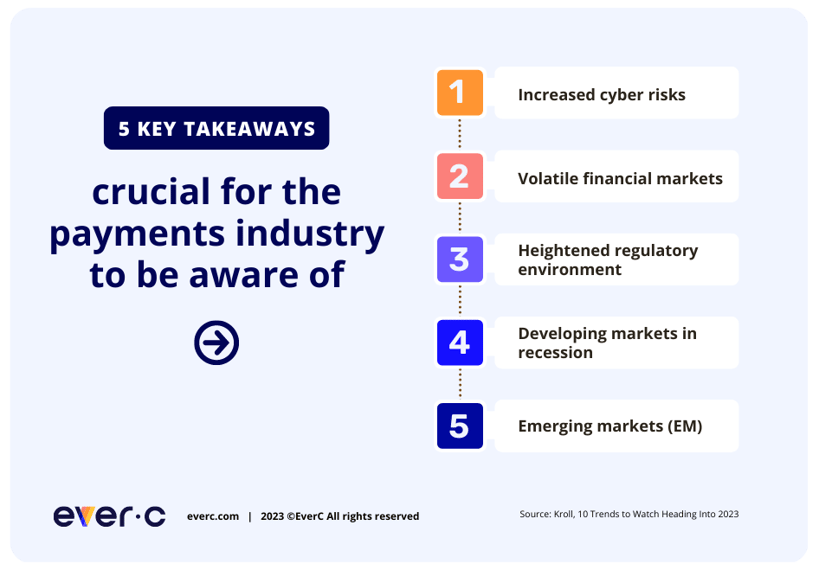5 Key Trends from Kroll’s 2023 Predictions
By EverC Team , Industry Trends, Expertise & InsightsHere at EverC, we have the good fortune of working with some amazing industry partners like Kroll to stay on top of the latest industry trends and threats. Kroll, the leading independent provider of risk and financial advisory solutions, leverages its unique insights to help clients – and partners –meet the complex demands of the financial space.
In a recent report by the Kroll Institute, their experts shared predictions on the 10 trends to watch for in 2023. The report contains a wealth of insights, and now that we’re through the first quarter of the year, much of what they’ve discussed is already occurring. In fact, a few of these trends, such as the increased volatility of financial markets, have been thrown into sharp relief by recent events.
Our subject matter experts identified 5 key takeaways that are crucial for our customers and partners in the payments industry to be aware of.
Increased cyber risks It’s no real surprise that cyberattacks will continue to be a major concern in 2023. According to Alan Brill, senior managing director of Kroll’s Cyber Risk practice, “There should be no question that cyber-related threats will continue to evolve and remain a constant danger to every public and private sector organization.” Cyber threats will have widespread impact as they become increasingly sophisticated and harmful.
What does this mean for payment providers? Cryptocurrency and decentralized finance are identified as being at particularly high risk for being attacked by cybercriminals this year.
Volatile financial markets With the inflated costs of everything from raw materials to labor, earnings pressure is expected to continue in 2023 for many companies, even as they may pass off some of the additional costs to consumers. Volatility can also be seen in the rising inflation, the threat of a recession, and the recent collapse of prominent banks such as Silicon Valley, Signature, and Sterling.
Economic uncertainty is already dampening consumer spending. The Kroll report pointed out that “consumer confidence remains at historically low levels, which may lead to a decline in demand for goods and services or switching to low-cost offerings, which is not a good omen for revenue.”
What does this mean for payment providers? Our experts see this as a red flag that signals the potential increase in the sale of counterfeit products online, as consumers look for cheaper alternatives.
Heightened regulatory environment On the heels of a “very aggressive and regulatory agenda” executed in 2022, Kroll experts believe the SEC is expected to refocus its priorities to address the realities of change in control of the U.S. House, potential recessionary stress on the financial markets, ever increasing concerns over fraud and the contagion effect of volatility and liquidity in the cryptocurrency market.”
What does this mean for payment providers? One thing that stood out for us was Kroll’s prediction that the SEC will prioritize new rules in a number of key areas including cyber security. Our experts believe this will place a heavier on payment providers to take greater measures to mitigate fraud risks.
Developing markets in recession There’s no doubt that we are living in trying times right now, but there is always a bright side. “Rarely has the world faced this many interconnected crises, but there is always opportunity in volatility,” said Megan Green, Kroll’s global chief economist. Kroll expects the U.S. recession to hit in the second half of 2023, while there still may be ongoing concerns around lifting the debt ceiling.
“Our base case scenario is that there will be a standoff over the debt ceiling, but ultimately there will be bipartisan agreement on raising it. If this is wrong and the U.S. were to default on its debt, it would be catastrophic for not only the U.S. but also for the global markets,” the report said.
What does this mean for payment providers? Consumers try to hold on to their money during recessionary periods, so they’ll try to cut corners where they can. Our experts see the potential for this to boost counterfeiting and cyber threats, which means payment providers will have to do more than ever to outsmart cybercriminals Emerging markets
Emerging markets (EM) are expected to grow and will help give a boost to the “lackluster” overall global economy in 2023. However, on the downside, the sovereign debt crisis will continue to be an issue for emerging markets, some of which overleveraged their economies with debt before and during pandemic. Kroll predicts some low- and middle-income countries will seek to restructure their debt under the G20’s Common Framework, while some countries may also default due to rate hikes. What does this mean for payment providers? As acquirers and PSPs seek out new growth opportunities, they may look to emerging markets to balance losses from the difficult economic climate. It’s important to be aware that any new market carries risk, and take steps to monitor differences in regulations and structures from region to region.
Conclusion
Reports like this offer the insights and knowledge for us to stay ahead of industry trends and help our customers in the payments industry do the same. In addition to the five takeaways we have outlined here, our team of experts is constantly monitoring relevant news.
Read Kroll’s full report for more details on these trends and others, including developing global trade tensions, the war on Ukraine, “old” and “tropical” infectious disease outbreaks, and increased ESG regulations, transparency, and scrutiny. It is packed with valuable information and deeper insights to be aware of as we move through the year.
